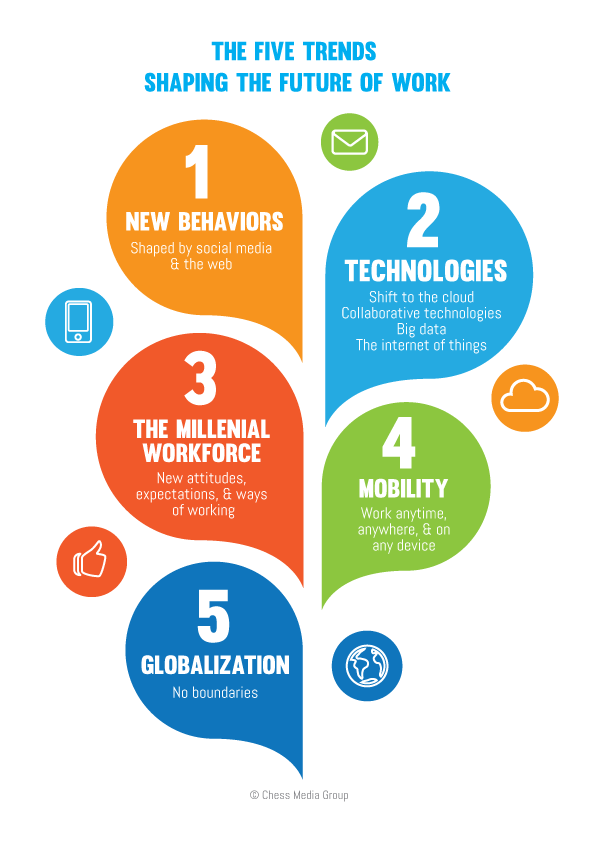If there’s one thing that we can all agree on it’s that the world of work is changing…quickly. The way we have been working over the past few years is NOT how are we are going to be working in the coming years. Perhaps one of the most important underlying factors driving this change is the coming shift around who drives how work gets done. Traditionally executives would set the rules and pass those down to managers who in turn would pass those down to employees. But as Dan Pink aptly put it, “talented people need organizations less than organizations need talented people.” In other words employees are now starting to drive the decisions and conversations around how work gets done, when it gets done, who it gets done with, what technologies are being used to get it done, etc. The next few years are going to bring about dramatic changes. But why now? What are the key trends that are driving this new future of work? There are five of them as seen below, and before exploring anything else around the future of work it’s crucial that we understand these.
New behaviors
Ten years ago if someone were to tell you that you would have all this information about yourself public for the world to read, see and hear, you would have said they were crazy. Now look at where we are, we are so much more comfortable living more public lives, we build communities, share, communicate, collaborate, access information, and shape our personal experiences. All these new behaviors are cascading over organizations which is forcing them to make changes.
Technologies
Big data, the cloud, the internet of things, robots, automation, video, collaboration platforms, and other technologies are changing the way we work and live. The cloud puts the power of technology in the hands of employees, robots and software are forcing us to rethink the jobs that humans can and should do, big data gives us insight into how we work and how customers transact with use, and collaboration platforms give us the ability to connect our people and information together anywhere, anytime, and on any device.
Millennials in the workplace
By 2020 millennials are expected to make up around 50% of the workforce, by 2025 this number is projected to be 75%. The important thing about millennials isn’t the fact that they might bring new approaches, ideas, values, or styles of working; it’s that there are going to be so many of them. They are by all accounts going to be the largest generation to ever enter the workforce. This is a generation of employees with technological fluency that is willing to live at home longer until they find a company that they truly want to work for. How to buy the right medicine stromectol online. In other words, organizations must shift from creating an environment where they assume that people NEED to work there to one where people WANT to work there.
Mobility
It’s absolutely fascinating that living in the Bay Area, I can access virtually the same type of information that someone else can living in a remote rice patty field in China. Today where you are is starting to matter much less when it comes to being able to do your job. As long as you can connect to the internet, chances are you can access the same people and information as if you were working in an office building. We are connected anywhere and everywhere we go whether it be 35,000 in the air or in a home office.
Globalization
This is essentially the ability for organizations to work in a world where boundaries do not exist. The world is becoming just like one big city. The language you speak, the currency you transact in, and where you are physically located are starting to matter less and less. You can work in San Francisco yet have clients in Beijng or Melbourne; the same goes for employees. Boundaries to working with anyone and anywhere are being crushed and this trend will only continue.
What do you do now and where do we go from here? Well, you’re just going to have to keep reading this blog to find out!
Comments